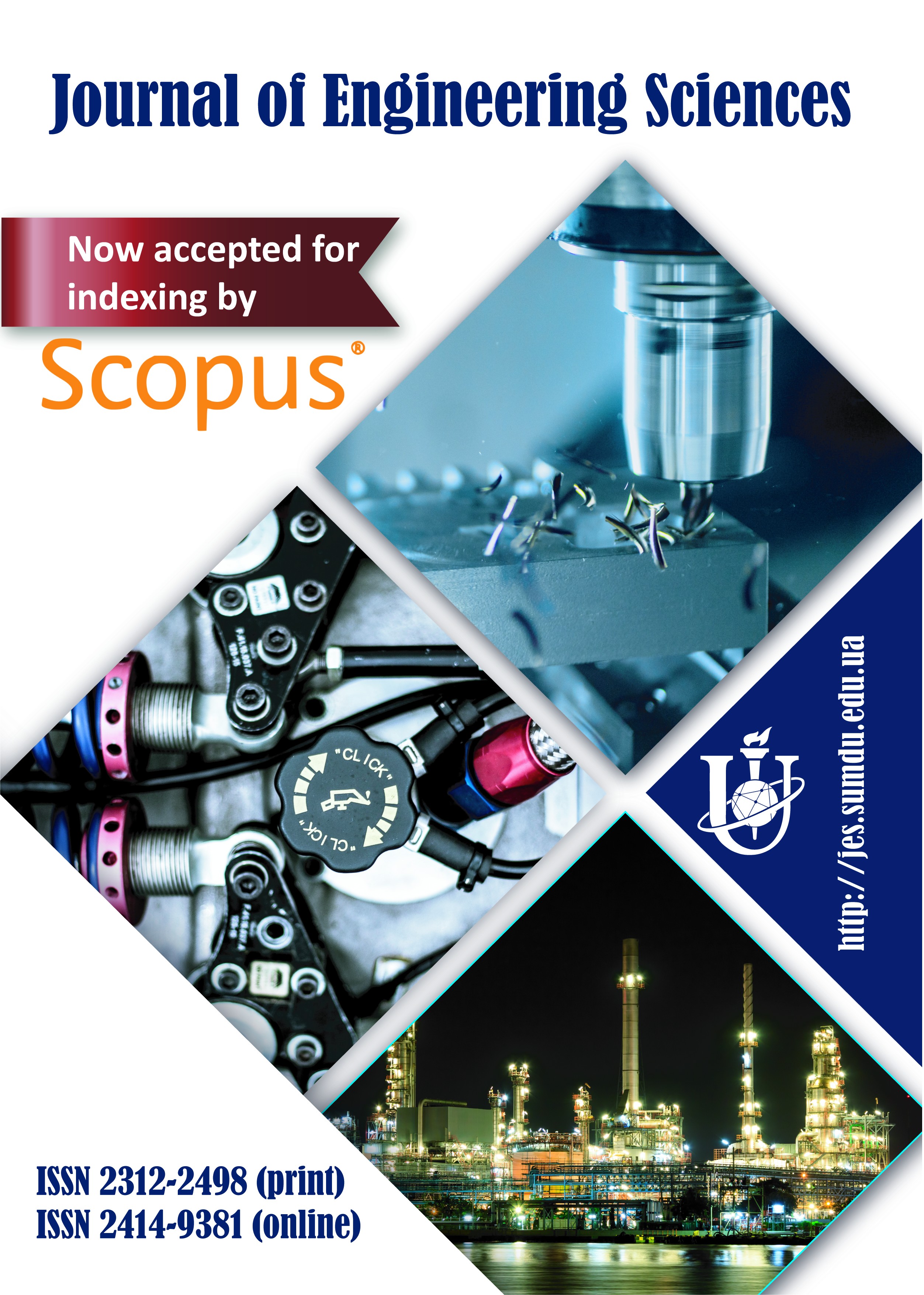Information-Extreme Machine Learning of Wrist Prosthesis Control System Based on the Sparse Training Matrix
Author(s): Suprunenko M. K.1*, Zborshchyk O. P.1, Sokolov O.2
Affiliation(s):
1 Sumy State University, 2, Rymskogo-Korsakova St., 40007 Sumy, Ukraine;
2 Nicolaus Copernicus University in Torun, 5, Grudziadzka St., 87-100 Torun, Poland
*Corresponding Author’s Address: [email protected]
Issue: Volume 9, Issue 2 (2022)
Dates:
Submitted: October 3, 2022
Accepted for publication: December 11, 2022
Available online: December 14, 2022
Citation:
Suprunenko M. K., Zborshchyk O. P., Sokolov O. (2022). Information-extreme machine learning of wrist prosthesis control system based on the sparse training matrix. Journal of Engineering Sciences, Vol. 9(2), pp. E28-E35, doi: 10.21272/jes.2022.9(2).e4
DOI: 10.21272/jes.2022.9(2).e4
Research Area: MECHANICAL ENGINEERING: Computational Mechanics
Abstract. The article considers the problem of machine learning of a wrist prosthesis control system with a non-invasive biosignal reading system. The task is solved within the framework of information-extreme intelligent data analysis technology, which is based on maximizing the system’s information productivity in machine learning. The idea of information-extreme machine learning of the control system for recognition of electromyographic biosignals, as in artificial neural networks, consists in adapting the input information description to the maximum total probability of making correct classification decisions. However, unlike neuro-like structures, the proposed method was developed within a functional approach to modeling the cognitive processes of the natural intelligence of forming and making classification decisions. As a result, the proposed method acquires the properties of adaptability to the intersection of classes in the space of recognition features and flexibility when retraining the system due to the recognition class alphabet expansion. In addition, the decision rules constructed within the framework of the geometric approach are practically invariant to the multidimensionality of the space of recognition features. The difference between the developed method and the well-known methods of information-extreme machine learning is the use of a sparse training matrix, which allows for reducing the degree of intersection of recognition classes significantly. The optimization parameter of the input information description, the training dataset, is the quantization level of electromyographic biosignals. As an optimization criterion is considered the modified Kullback information measure. The proposed machine learning algorithm results are shown in the example of recognition of six finger movements and wrist.
Keywords: information-extreme intelligent technology, machine learning, process innovation, sparse training matrix, prosthesis control system, information criterion, electromyographic sensor, biosignal.
References:
- Svensson, P., Wijk, U., Björkman, A., Antfolk, C. (2017). A review of invasive and non-invasive sensory feedback in upper limb prostheses. Expert Review of Medical Devices, Vol. 14(6), pp. 439–447, doi: 10.1080/17434440.2017.1332989.
- Roche, A. D., Rehbaum, H., Farina, D., Aszmann, O. C. (2014). Prosthetic myoelectric control strategies: a clinical perspective. Curr. Surg. Reports, Vol. 2(3), doi: 10.1007/s40137-013-0044-8.
- Zhang, T., Jiang, L., Liu, H. (2018). Design and functional evaluation of a dexterous myoelectric hand prosthesis with biomimetic tactile sensor. IEEE Trans. Neural Syst. Rehabil. Eng., Vol. 26(7), pp. 1391–1399, doi: 10.1109/TNSRE.2018.2844807.
- Liang, G., Wang, Y., Mei, D., Xi, K., Chen, Z. (2015). Flexible capacitive tactile sensor array with truncated pyramids as dielectric layer for three-axis force measurement. J. Microelectromechanical Syst., Vol. 24(5), pp. 1510–1519, doi: 10.1109/JMEMS.2015.2418095.
- Markovic, M., Dosen, S., Popovic, D., Graimann, B., Farina, D. (2015). Sensor fusion and computer vision for context-aware control of a multi degree-of-freedom prosthesis. J. Neural Eng., Vol. 12(6), doi: 10.1088/1741-2560/12/6/066022.
- Basturk, A., Yuksel, M. E., Caliskan, A., Badem, H. (2017). Deep Neural Network Classifier for Hand Movement Prediction. Proceedings of the 25th Signal Processing and Communications Applications Conference, SIU 2017, June 2017, doi: 10.1109/SIU.2017.7960566.
- Stango, A., Negro, F., Farina, D. (2015). Spatial correlation of high density EMG signals provides features robust to electrode number and shift in pattern recognition for myocontrol. IEEE Trans. Neural Syst. Rehabil. Eng., Vol. 23(2), pp. 189–198, doi: 10.1109/TNSRE.2014.2366752.
- Atzori, M., Cognolato, M., Müller, H. (2016). Deep learning with convolutional neural networks applied to electromyography data: A resource for the classification of movements for prosthetic hands. Front. Neurorobot., Vol. 10(SEP), 9, doi: 10.3389/fnbot.2016.00009.
- Gheorghe, M. (2015). A support vector machine approach for developing telemedicine solutions: medical diagnosis. Network Intelligence Studies, Vol. 3(1(5)), pp. 43-48.
- Rossi, M., Benatti, S., Farella, E., Benini, L. (2015). Hybrid EMG classifier based on HMM and SVM for hand gesture recognition in prosthetics. Proceedings of the IEEE International Conference on Industrial Technology, June 2015, pp. 1700–1705, doi: 10.1109/ICIT.2015.7125342.
- Olsson, A. E., Sager, P., Andersson, E., Björkman, A., Malešević, N., Antfolk, C. (2019). Extraction of multi-labelled movement information from the raw HD-sEMG image with time-domain depth. Sci. Rep., Vol. 9(1), doi: 10.1038/s41598-019-43676-8.
- Moskalenko, V. V., Korobov, A. G. (2017). Information-extreme algorithm of the system for recognition of objects on the terrain with optimization parameter feature extractor. Radio Electronics, Computer Science, Control, Vol. 2, pp. 61–69, doi: 10.15588/1607-3274-2017-2-7
- Subbotin, S. (2013). The neuro-fuzzy network synthesis and simplification on precedents in problems of diagnosis and pattern recognition. Optical Memory and Neural Networks, Vol. 22(2), .pp. 97–103, doi: 10.3103/s1060992x13020082.
- Dovbysh, A. S., Budnyk, M. M., Piatachenko, V. Yu., Myronenko, M. I. (2020). Information-extreme machine learning of on-board vehicle recognition system. Cybernetics and Systems Analysis, Vol. 56(4), pp 534–543, doi: 10.1007/s10559-020-00269-y.
- Dovbysh, A. S., Shelehov, I. V., Prylepa, D. V., Golub, I. (2016). Information synthesis of adaptive system for visual diagnostics of motional and mental state of a person. Eastern-European Journal of Enterprise Technologies, Vol. 4/9(82), pp. 11–17, doi: 10.15587/1729-4061.2016.75683.
- Dovbysh, A. S., Piatachenko, V. Y., Simonovskiy, J. V., Shkuropat, O. A. (2020). Iinformation-extreme hierarchical machine learning of the hand brush prosthesis control system with a non-invasive bio signal reading system. Radio Electron. Comput. Sci. Control, Vol. 4, pp. 178–187, doi: 10.15588/1607-3274-2020-4-17.
- Kaczmarek, P., Mańkowski, T., Tomczyński, J. (2019). PutEMG – A surface electromyography hand gesture recognition dataset. Sensors, Vol. 19(16), 3548, doi: 10.3390/s1916354.







